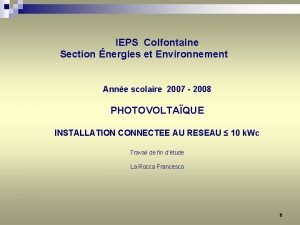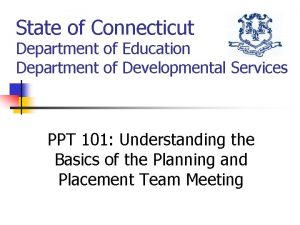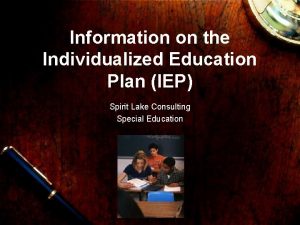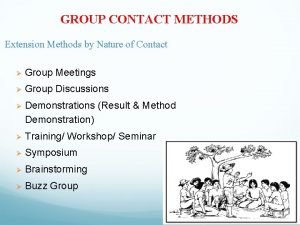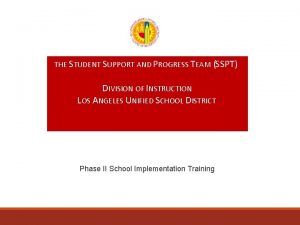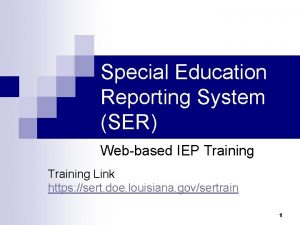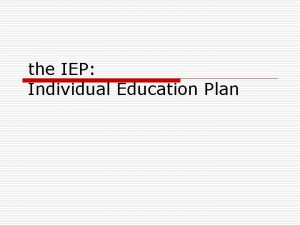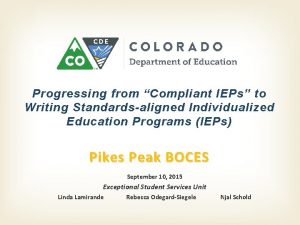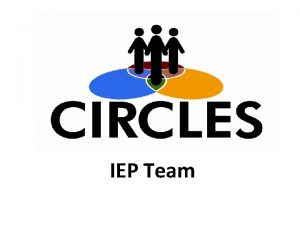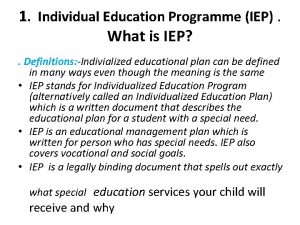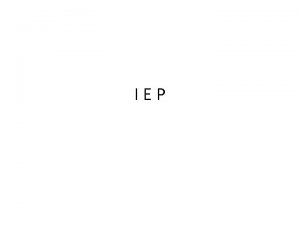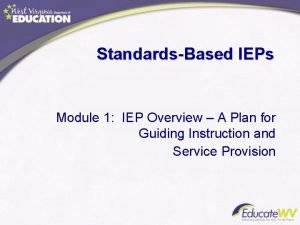Standardsaligned IEPs An Individual Education Plan IEP identifies







- Slides: 7

Standards-aligned IEPs An Individual Education Plan (IEP) identifies the services, supports, and elements of specially designed instruction that address the unique needs of a student with a disability needed to enable that student to participate in the general curriculum and address the standards for the grade in which the student is enrolled.

Standards-aligned IEPs Contributing Factors to the Performance Gap IEPs can set the stage for academic and behavioral expectations for educators, students, and parents. Problems can occur when: • the IEP sets academic goals that are not aligned with the grade level standards • the IEP does not address supports needed to address the grade level standards • the IEP does not address appropriate educational materials

Standards-aligned IEPs For students in the secondary grades who are still struggling with reading or basic math skills, educators may decide to provide remedial services to help the students “get ready” to address the standards. Unfortunately, “ready means never. ” IEPs must address the supports needed for students with disabilities to address the standards for the grade in which they are enrolled. Otherwise they will never be prepared for assessments based on the grade level standards.

Standards-aligned IEPs: • are based on the student’s educational needs identified in the present level of performance and aligned to the standards for the grade in which the student is enrolled • have goals that address a variety of skills and behaviors for satisfactory or proficiency on the grade level standards • consider any needed assistive technology, accommodations, and accessible educational materials

Standards-aligned IEPs Resources • Quality IEPs Manual – http: //bit. ly/2 Fo. W 463 – A comprehensive manual on the development of quality IEPs. • Dear Colleague Letter from OSERS on Standardsaligned IEPs with Highlights – http: //bit. ly/2 mfum 2 P – Clear language on the requirement that IEPs be aligned to the standards for the grade in which a child is enrolled. – Includes an example of the focus of an IEP and the services needed for a student to address the grade level standards.

Standards-aligned IEPs Data Sources – Below are strategies you can use to collect information support standards-aligned IEPs. • Use these survey questions on assistive technology, accessible educational materials, and universal design for learning to gauge knowledge and understanding with principals, teachers, and parents - http: //bit. ly/2 mg 6 Sd. K • Review a random sample of IEPs and check for alignment with standards for which the student is enrolled.

Standards-aligned IEPs Hypothesis - The problem is occurring because: – the goals on the IEPs are not aligned with the standards for the grade in which the student is enrolled – the goals on the IEPs do not address skills and behaviors needed to attain satisfactory or proficiency on the grade level standards – the IEPs do not address whether or not the educational materials are appropriate for the students – the IEP team members do not possess critical understandings (effects of the disability on learning, the grade level standards, assistive technologies, accommodations, accessible educational materials, etc. )
